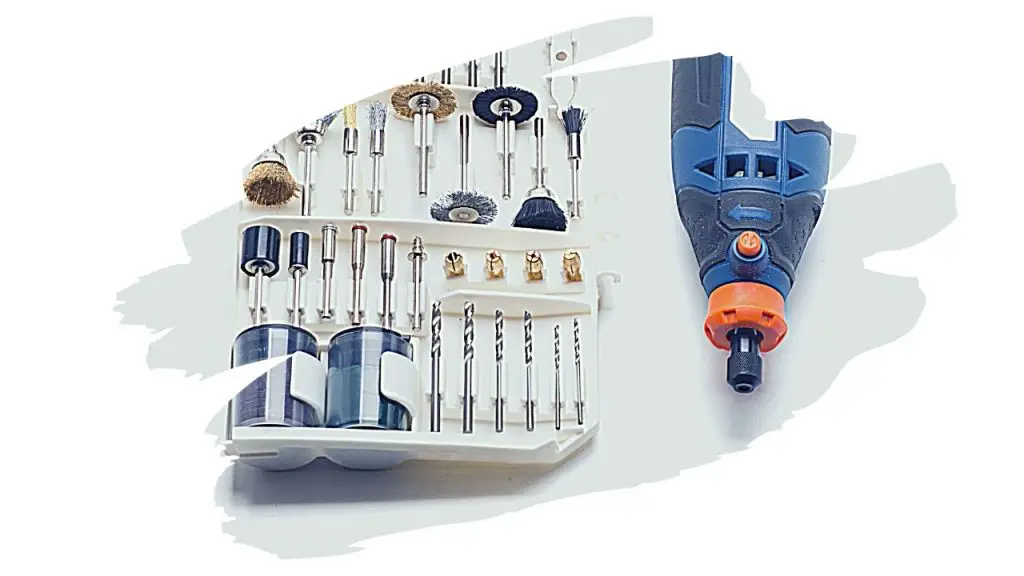Dremel’s are incredibly useful hand-held power tools. With their wide range of drill bits, they are a dream multi-tool for making small crafts.
They can cut and carve wood, or buff and polish metal. And they can even be used to engrave into stone.
Yet these multi-functional items can sometimes become a little loud. And in the worst cases, they can start to reach teeth-rattling noise levels.
So, how do you silence a Dremel (or at the very least make it quieter)?
Dremel tools, by their very high spinning nature, are going to be very noisy. But you can do a few things to reduce that noise;
- Adjust the speed. If you have a Dremel with an adjustable speed, then put it on a lower speed. At low speeds Dremels are surprisingly quiet (for a power tool).
- Adjust your handling. When you handle the Dremel, you can try squeezing the tool and compressing the central casing. This can help reduce noise levels.
- Check the bearings. If your Dremel is making an ear-splitting squeal, it’s time to the check the bearings. They might need lubricating, or they may be worn down and need replacing altogether.

This post may contain affiliate links to products that we receive a commission for (at no additional cost to you). Learn more here.
Why Are Dremels Loud?
Well, technically Dremels aren’t meant to be all that loud at all. The tool, (provided its bearings are in tip top shape), is fairly quiet.
The loud noise emitted when using a Dremel tool is the result of it cutting into materials, such as wood and metal.
So, How Loud Is A Dremel Tool?
If we were to compare the sound of a free-spinning Dremel tool to a household item, it would be about as noisy as hairdryers. Or, a gas-powered lawnmower (around 85 decibels of noise).
That’s much quieter than other woodworking power tools such as a Circular Saw (95 decibels), or a Hammer Drill (which emits sound at whopping 110 decibels!).
What Causes All That Dremel Tool Noise?
If your Dremel is very loud, (even when it is not cutting into material), then that is usually an indicator that something is wrong with the tool itself.
Now, the most obvious culprit tends to be the Dremel bearings. Dremel bearings should be regularly greased, to prevent them from drying out. If you don’t maintain them, then they can become damaged.
However, if the bearings don’t seem to be the noise maker, then maybe the tool bit could be the sound culprit.
And why is that? Well, if the bit is suffering from some wear and tear, this will make your Dremel wobble – which in itself could be another cause of all that noise.
Why Does My Dremel Wobble?
Dremel wobble can be caused by a few things, but most commonly it is caused by the tool bit becoming worn down on just one side. So every time you try to cut (especially at high speeds) the tool will wobble around.
The combination of cutting with a vibrating wobbly power tool will make your Dremel tool needlessly louder.
How Do I Make My Dremel Quieter?
If you want to make your Dremel quieter, you will need to first identify why it is making the noise.
The Noise Comes From The Bearings (They’re Making A High Pitch Squealing)
If the Dremel is making a high pitch screeching sound, then you need to check if the bearings are properly lubricated.
How To Grease and Lubricate Dremel Bearings
Not sure how to oil your Dremel bearings? Or maybe you are a little wary about how to open it up and take a look inside?
If that’s the case, then watch the Idle Genius tutorial video below to learn how:
What Type Of Oil Should I Use To Lubricate The Bearings? Any machine oil that’s offers decent lubrication will do, for example Sewing Machine Oil. But don’t use WD-40! WD-40, whilst great for bike chains, is not great as a lubricant for rolling bearings. And stick to only using a small droplet of thin light machine oil (applied with a cotton bud).
The Noise Comes From It Wobbling Around
If this is the case, it is time to check the condition of the bit and see if it needs replacing.
Go grab your Dremels owner manual, and find the instructions for checking and replacing the bit. This is usually in the section titled: ‘Changing Accessories’.
The technique used to remove/insert the bit can differ according to the specific model.
The Noise Comes From Actually Cutting Into Wood/Metal/Plastic
This is to be expected, and is the nature of cutting into material using a high-speed power tool.
Cutting into wood shouldn’t be too noisy. However, if the sound is still too much for you, then it’s time to invest in some quality noise-canceling headgear to protect your hearing.
If you want something that will protect your eardrums, (whilst also allowing you to listen to your favorite music, podcasts, or audiobooks as you work), then 3M’s WorkTunes Connect Hearing Protector with Bluetooth Technology is ideal.
They’ll even allow you to take calls from your phone, (thanks to its integrated microphone), without ever having to remove your headgear.
Check out the latest prices here for the WorkTunes Connect on Amazon.
The Noise Comes From… Well, I Actually Don’t Know!
If your Dremel has been put through some 50 to 60 hours of hard use, it probably is due for a bit of maintenance and TLC.
Namely, you are going to need to open up the brush caps (unplugging the tool first!) and check the condition of the carbon brushes.
If they are worn down, (there’s less than one-eight of the carbon left on the brushes), then you need to look into getting them replaced.
U.S. Skull Hunter’s video below will show you how to easily swap out those worn out motor brushes;
If you’d rather not do some DIY Dremel repair, (and you still have your warranty), you can always reach out to Dremel directly to access their authorized service centers instead.
You can contact Dremel USA by phone on 1-800-437-3635 (8am-5pm CT Mon-Fri)
Final Thoughts
You can never really silence a Dremel, its the very nature of this beast of a tool to make a fair amount of noise as you cut through timber.
But, you can reduce the noise levels a fair bit by simply using the Dremel at a low-speed (if you have an adjustable speed tool). You can also double check the bearings to see if they are lubricated (dry bearings can be super noisy).
And if all else fails, you can send your Dremel in for servicing and have them take a look over the machine for you.
References
https://www.cdc.gov/nceh/hearing_loss/what_noises_cause_hearing_loss.html



